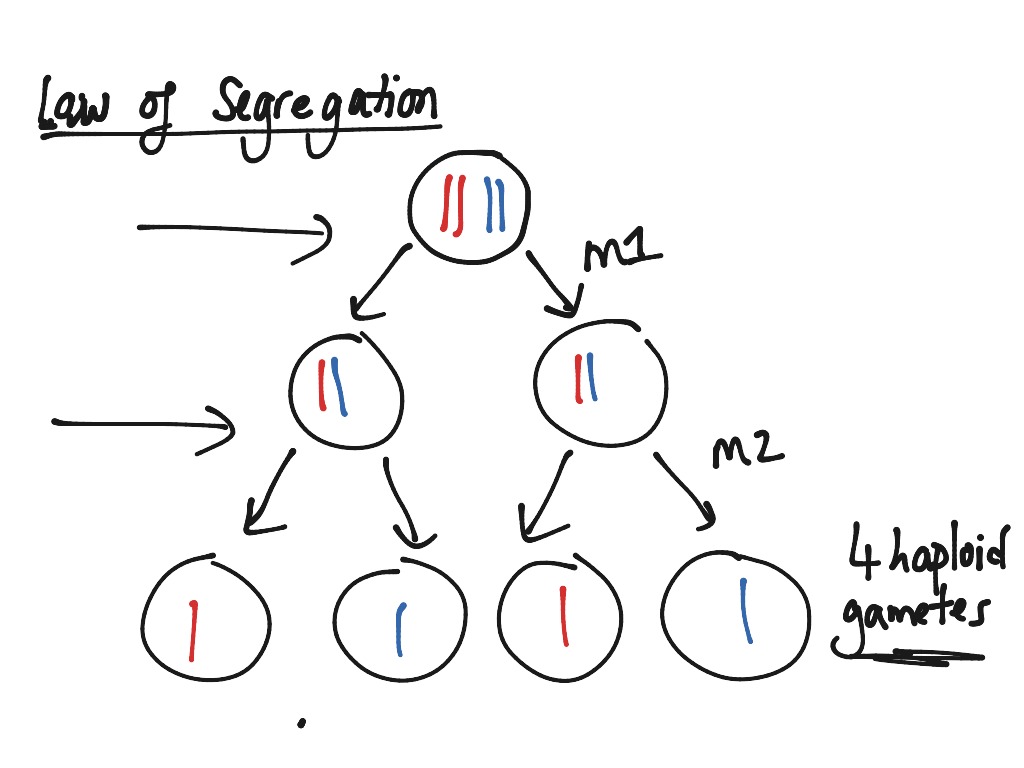The law of segregation is a principle in genetics that states that during the formation of gametes (sperm and egg cells), the two alleles (different versions of a gene) for a trait separate from each other so that each gamete carries only one allele.
This means that when the sperm and egg unite during fertilization, each offspring receives one allele from each parent for each trait, which explains why offspring exhibit a combination of features from both parents.
The law of segregation is a key concept in genetics and serves as a basis for understanding inheritance patterns.
Real-Life Examples of Law of Segregation
The law of segregation can be observed in many real-life scenarios. Let’s look at a few examples.
1. Human Eye Color
The gene that codes for eye color has multiple forms or alleles. One allele may produce brown eyes, while another produces blue eyes. If an individual inherits two copies of the same allele, they will have that eye color. However, if they inherit one dominant allele and one recessive allele, the dominant allele will determine their eye color. The law of segregation ensures that the alleles for eye color are randomly distributed to offspring, resulting in a range of eye colors among individuals. This is why some families may have a variety of eye colors despite having the same parents.
2. Blood Type Inheritance
In the case of blood type inheritance, there are three possible alleles: A, B, and O. Each individual inherits two of these alleles, which determine their blood type. The A and B alleles are codominant, meaning they both express their traits if present, while the O allele is recessive and only expressed if no A or B allele is present. If one parent has blood type A and the other has blood type B, they each contribute one A or B allele, resulting in offspring with one of four possible genotypes: AA (blood type A), AB (blood type AB), BB (blood type B), or AO (blood type A with a recessive O allele). When two parents who are both type A have a child who is type O, it is because each parent carries one copy of the O allele and passed it down to their child.
3. Sickle Cell Anemia
Anemia is caused by a mutation in the HBB gene, which provides instructions for making hemoglobin. If an individual carries one normal HBB allele and one sickle cell allele, their gametes will have a 50/50 chance of carrying either allele. If two individuals who carry one sickle cell allele each have children, there is a 25% chance that the child will inherit two sickle cell alleles and develop sickle cell anemia. There is a 50% chance that the child will inherit one sickle cell allele and one normal HBB allele, making them a disease carrier.
4. Animal Coat Color
In horses, the gene for coat color comes in two alleles: one for black and one for chestnut (brown). If a horse has one copy of the gene for black coat color and one copy for brown coat color, it will have offspring that inherit either the black or brown gene from each parent. If the offspring inherit both black genes, they will have a black coat; if they inherit both brown genes, they will have a brown coat; and if they inherit one of each gene, they will have a coat color that is a mixture of black and brown.
5. Flower Color in Plants
Let’s consider a hypothetical plant species with a dominant gene for red flower color (R) and a recessive gene for white flower color (r). If an individual plant inherits the genotype RR, it will have red flowers because the dominant red gene is expressed. If it inherits the genotype rr, it will have white flowers because the recessive white gene is expressed. If it inherits the genotype Rr, it will also have red flowers because the dominant red gene is expressed and masks the recessive white gene.
6. Personal Traits
Genetic factors can influence personality traits. Two introverted parents have a high chance of having an introverted child. If two introverted parents have an extroverted child, it may be due to inherited alleles for personality traits from both parents.
7. Huntington’s Disease
Huntington’s Disease is caused by a mutation in the huntingtin gene that produces a toxic protein. An individual with one copy of the mutated huntingtin gene and one copy of the normal gene is considered a disease carrier. This individual has a 50% chance of passing the mutated gene to their offspring due to the law of segregation. If the carrier has children, each child will inherit one copy of the gene from their parent, either the mutated or the normal gene. If the child inherits the mutated gene, they will eventually develop Huntington’s disease.
8. Skin Color
There are multiple genes involved in determining an individual’s skin pigmentation. Combining these genes will determine whether an individual has light or dark skin. If both parents have the same skin color genes, the child will likely have the same skin color. When two parents with darker skin tones have a child with lighter skin, each parent carries one copy of the allele for lighter skin and passes it down to their child.
9. Hair Texture
An individual’s hair texture is determined by the genes inherited from their parents. Two alleles of the same gene control hair texture: “curly” hair and “straight” hair. If an individual inherits two copies of the curly allele, they will have curly hair. They will have straight hair if they inherit two copies of the straight allele. However, they will have wavy hair if they inherit one copy of each allele.
Image Source: 1, 2, 3

